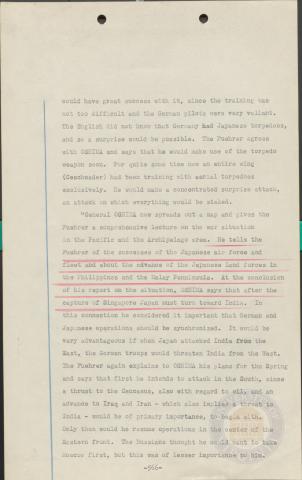
Page 566
| Parent | Collaboration between Japan, Germany and Italy Vol. VII |
|---|---|
| Date | |
| Language | English |
| Collection | Tavenner Papers & IMTFE Official Records |
| Box | Box 15 |
| Folder | Japan, Germany, Italy Collaboration Vol 7 |
| Repository | University of Virginia Law Library |
could have great success with it, since the training was not too difficult and the German pilots were very valiant* The English did not know that Germany had Japanese torpedoes, and so a surprise would be possible. The Fuehrer agrees with OSHIMA. and says that he would make use of the torpedo weapon soon. For quite some time now an entire wing (Ceschwader) had been training with aerial torpedoes exclusively. He would make a concentrated surprise attack, an attack on which everything would be staked.
"General OSHIMA. now spreads out a map and gives the Fuehrer a comprehensive lecture on the war situation in the Pacific and the Archipelago area. He tells the Fuehrer of the successes of the Japanese air force and fleet and about the advance of the Japanese land forces in the Philippines and the Malay Penninsula. At the conclusion of his report on the situation, OSHIMA says that after the capture of Singapore Japan must turn toward India. In this connection he considered it important that German and Japanese operations should be synchronized. It would be very advantageous if when Japan attacked India from the East, the German troops would threaten India from the West. The Fuehrer again explains to OSHIMA his plans for the Spring and says that first he intends to attack in the South, since a thrust to the Caucasus, also with regard to oil, and an advance to Iraq and Iran - which also implies a threat to India - would be of primary importance, to begin with. Only then would he resume operations in the center of the Eastern front. The Russians thought he would want to take Moscow first, but this was of lesser importance to him.
